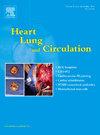Computed Tomography Coronary Angiography Versus Stress Echocardiography in a Rapid Access Chest Pain Clinic
IF 2.2
4区 医学
Q2 CARDIAC & CARDIOVASCULAR SYSTEMS
引用次数: 0
Abstract
Background
Outpatient rapid-access chest pain clinics (RACPCs) investigate and manage low-to intermediate-risk chest pain. Several non-invasive investigations have been employed for RACPCs, including stress echocardiography (SE) and computed tomography coronary angiography (CTCA). However, research on the influence of these tests on diagnosis and management in this setting is limited. This study aimed to determine whether patients who underwent CTCA differed in their risk profile, diagnosis, and management compared to those who underwent SE in RACPC.
Method
This retrospective single-centre observational study included 903 patients who presented to the RACPC with low-to-intermediate-risk chest pain. Patients were investigated using SE and/or CTCA at the discretion of the treating cardiologist.
Results
Overall, 68.4% of the patients were initially investigated using SE vs CTCA. Individuals with cardiac risk factors, including male patients and those using lipid-lowering agents before the RACPC review, were more likely to be initially investigated with CTCA. Patients who underwent CTCA at any point during their clinic visit had higher rates of invasive angiography, coronary intervention, and cardiac specialist referral than those who underwent SE alone. Patients who received CTCA at any time had higher prescription rates of antiplatelet, antihypertensive, and lipid-lowering medications, irrespective of whether they underwent invasive angiography, compared to the SE-only group.
Conclusions
SE remains a popular initial screening method for patients with RACPC with low-to-intermediate-risk profiles. More men had CTCA, and more women had SE in their initial investigation. Patients investigated using a CTCA strategy were more likely to undergo invasive coronary angiography, procedural intervention, and the initiation of antiplatelet, antihypertensive, and lipid-lowering medications.
计算机断层冠状动脉造影与压力超声心动图在快速进入胸痛诊所。
背景:门诊快速获取胸痛诊所(RACPCs)调查和管理低至中危胸痛。RACPCs采用了几种非侵入性检查,包括应激超声心动图(SE)和计算机断层冠状动脉造影(CTCA)。然而,在这种情况下,这些测试对诊断和管理的影响的研究是有限的。本研究旨在确定在RACPC中接受CTCA的患者与接受SE的患者在其风险概况、诊断和管理方面是否存在差异。方法:这项回顾性单中心观察性研究包括903例向RACPC就诊的低至中危胸痛患者。在治疗心脏病专家的决定下,使用SE和/或CTCA对患者进行调查。结果:总体而言,68.4%的患者最初使用SE与CTCA进行调查。有心脏危险因素的个体,包括男性患者和在RACPC审查前使用降脂药物的患者,更有可能在CTCA的初始研究中进行调查。在门诊就诊期间接受CTCA的患者比单独接受SE的患者有更高的侵入性血管造影、冠状动脉介入和心脏专科转诊率。在任何时间接受CTCA的患者,无论是否接受侵入性血管造影,与仅接受se的患者相比,抗血小板、降压和降脂药物的处方率更高。结论:SE仍然是低至中等风险的RACPC患者的一种流行的初始筛查方法。在最初的调查中,更多的男性患有CTCA,更多的女性患有SE。使用CTCA策略的患者更有可能接受侵入性冠状动脉造影、程序性干预,并开始使用抗血小板、降压和降脂药物。
本文章由计算机程序翻译,如有差异,请以英文原文为准。
求助全文
约1分钟内获得全文
求助全文
来源期刊

Heart, Lung and Circulation
CARDIAC & CARDIOVASCULAR SYSTEMS-
CiteScore
4.50
自引率
3.80%
发文量
912
审稿时长
11.9 weeks
期刊介绍:
Heart, Lung and Circulation publishes articles integrating clinical and research activities in the fields of basic cardiovascular science, clinical cardiology and cardiac surgery, with a focus on emerging issues in cardiovascular disease. The journal promotes multidisciplinary dialogue between cardiologists, cardiothoracic surgeons, cardio-pulmonary physicians and cardiovascular scientists.
 求助内容:
求助内容: 应助结果提醒方式:
应助结果提醒方式:


